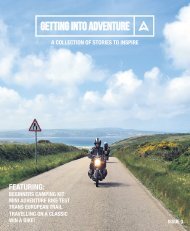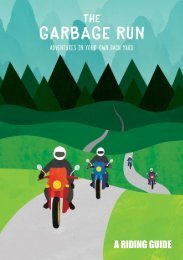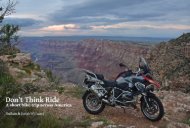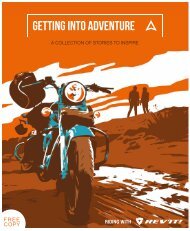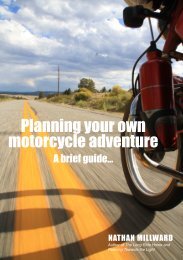Getting into Adventure Green
Create successful ePaper yourself
Turn your PDF publications into a flip-book with our unique Google optimized e-Paper software.
BUILDING AN ADVENTURE BIKE<br />
IT’S HARD TO IMAGINE THE PROCESS OF BUILDING A BIKE THESE DAYS.<br />
HERE WE SPEAK TO CHRISTOFER RATCLIFFE, LEAD DESIGNER OF THE CCM GP450<br />
ADVENTURE, ABOUT THE DESIGN AND BUILD PROCESS OF THAT BIKE...<br />
Where<br />
did<br />
the<br />
idea for the<br />
GP450 begin?<br />
It was born out<br />
of a conversation<br />
at CCM, back in<br />
2010, about how<br />
the rising boom in off-road capable<br />
adventure bikes was full of road<br />
based travel bikes that had been<br />
adapted to tackle the rough stuff.<br />
We thought, wouldn’t it be great if<br />
we could turn a bike full of natural<br />
off-road DNA <strong>into</strong> a travel bike.<br />
How did you get involved with the<br />
project and what were you doing<br />
before this?<br />
I was working not too far away,<br />
designing large industrial machines<br />
used for coating oil and gas<br />
pipelines. I was absolutely loving it,<br />
but then happened to come across<br />
an ad for a motorcycle Design<br />
Engineer role around the corner<br />
from my house. I immediately<br />
picked up the phone and shortly<br />
after went to meet Austin at the<br />
factory. Luckily I had a bit of a<br />
background in Automotive design<br />
from University and a short spell<br />
as a development engineer at<br />
TVR, so Austin gave me a chance.<br />
CCM were very old school in their<br />
approach to designing bikes, so I<br />
think I just came at the right time<br />
and could operate the new fangled<br />
PC and CAD system!<br />
For the first 6 months or so I was<br />
working with the MX race team,<br />
trying to quickly catch up on the<br />
development and testing CCM had<br />
done on the race bikes and bonded<br />
chassis.<br />
What were the particular<br />
challenges in designing a bike of<br />
this nature?<br />
When we sat down and made a<br />
list of dream specifications and<br />
geometry for the bike we realised<br />
why it hadn’t been done before.<br />
Everything you want on a nimble<br />
off-road bike was the total opposite<br />
of what you want on a comfortable<br />
long range travel bike.<br />
Trying to create a low seat height<br />
combined with MX style ground<br />
clearance whilst trying to keep a<br />
comfortable all-day riding position<br />
was tricky to say the least.<br />
Adding 20-litres of fuel on the<br />
bike was difficult. We didn’t<br />
want to compromise the narrow<br />
standing off-road position or<br />
compromise the long seat to slide<br />
up to shift weight over the front or<br />
compromise the weight distribution<br />
of the bike. Affecting any one of<br />
these would have taken away from<br />
the off-road capabilities. And<br />
believe me, the whole Clews family<br />
are off-road perfectionists so would<br />
not compromise one bit on how the<br />
bike performed in the dirt.<br />
“STARTING FROM<br />
THE GROUND UP<br />
WAS A BREATH OF<br />
FRESH AIR”<br />
After a few years of testing and<br />
changes we finally settled on a set<br />
up that felt as stable as a 600cc road<br />
bike on the road, but was as easy<br />
as a 250cc enduro on really tough<br />
off-road.<br />
Where do you even begin in the<br />
process of designing a new bike<br />
from the ground up?<br />
Starting from the ground up with<br />
a blank sheet was really a breath<br />
of fresh air. Once we had set the<br />
geometry and essential spec of<br />
the bike we set to designing the<br />
bike on the screen up to a point<br />
where we were happy to produce<br />
a CNC billet aluminium chassis<br />
to create a rolling test mule. The<br />
bonded ali chassis really is the<br />
secret of the GP450 as it allows<br />
us to control the vibration, stress<br />
and weight distribution of the bike<br />
with much higher accuracy than<br />
a welded frame as it is treated as<br />
a solid block of material with no<br />
unquantifiable stress points around<br />
weld points.<br />
The bike has been designed for<br />
function far above all else. If it<br />
looks purposeful and utilitarian it’s<br />
just because it is rather than being<br />
styled to look that way.<br />
Deciphering the mountain of<br />
European type approval documents<br />
and regulations is enough to send<br />
anyone to sleep. The time and<br />
expense of gaining these type<br />
approvals is by far and away the<br />
most difficult part of getting a new<br />
bike to market.<br />
Specifically, what are the<br />
challenges facing a small volume<br />
manufacturer such as CCM?<br />
We get the expected troubles of a<br />
small scale manufacture. When<br />
we are developing, or specifying<br />
equipment such as suspension,<br />
brakes exhaust etc it is pot luck<br />
to whether the supplier is dealing<br />
with a large development project<br />
or production run for a bigger<br />
manufacturer. It can get frustrating<br />
being pushed down the queue as<br />
it has a much bigger impact on a<br />
small company like CCM.<br />
We do love the David and Goliath<br />
battle and it really feeds us all to work<br />
harder and try to create something<br />
better than what’s already out there.<br />
I guess that’s the competitive racing<br />
nature coming through.<br />
The flip side of being a small family<br />
orientated manufacturer is that we<br />
have a great relationship with every<br />
CCM owner we have met. Ask any<br />
of them and I’m sure they will tell<br />
you the same. In the early days of<br />
the GP450 we must have had 100<br />
people test riding the prototypes<br />
and pre-production bikes. Each<br />
test rider offered different opinions<br />
based on how they would use the<br />
bike, what experiences they had<br />
when out on previous adventures<br />
and made some suggestions on<br />
design features or options. The<br />
GP450 was really moulded by these<br />
people in the early days.<br />
When the design was frozen while<br />
we were going through the Type<br />
approval process, any suggestions<br />
then began to grow <strong>into</strong> the huge<br />
range of after-market options we<br />
have now. The GP450 really felt like<br />
a bike of the people.<br />
In terms of the engine, how<br />
difficult is it for a small volume<br />
manufacturer to source an engine<br />
and how crucial was engine choice<br />
in the GP450?<br />
CCM have good relationships for<br />
many years with most manufacturers<br />
of motorcycles and engines. The<br />
difficult part is choosing the right<br />
engine to ideally suit our very<br />
specific requirements. The BMW<br />
Chris’s own bike, with a few tweaks<br />
28 Find out more at www.getting<strong>into</strong>adventure.com




